Analyzing Strategic Human Resources: Training, Diversity, Performance
VerifiedAdded on 2024/05/30
|12
|3438
|439
Report
AI Summary
This report provides a comprehensive analysis of strategic human resource management, focusing on key functions such as training and development, diversity and equality, and performance management. It explores strategic approaches to employee training, including technology-based training, group discussions, on-the-job training, and role-playing methods. The report also emphasizes the importance of coaching in building employee competency and fostering a positive work environment. Furthermore, it discusses the significance of diversity and equality policies in ensuring fair treatment and promoting inclusivity within organizations. The report concludes by examining performance management processes and highlighting the contribution of HR practices to employee performance. Desklib offers a platform for students to access this and other solved assignments for academic support.
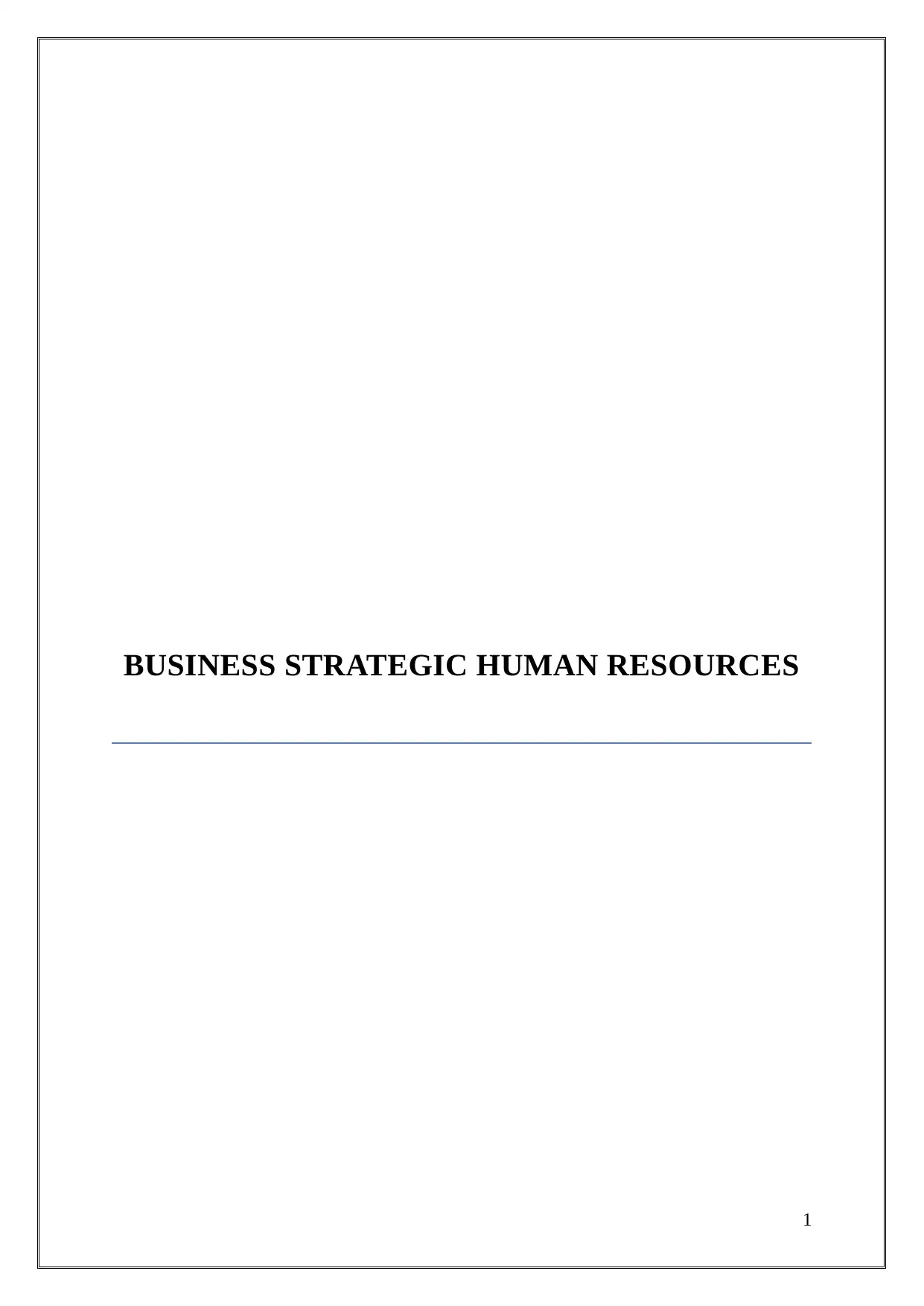
BUSINESS STRATEGIC HUMAN RESOURCES
1
1
Paraphrase This Document
Need a fresh take? Get an instant paraphrase of this document with our AI Paraphraser
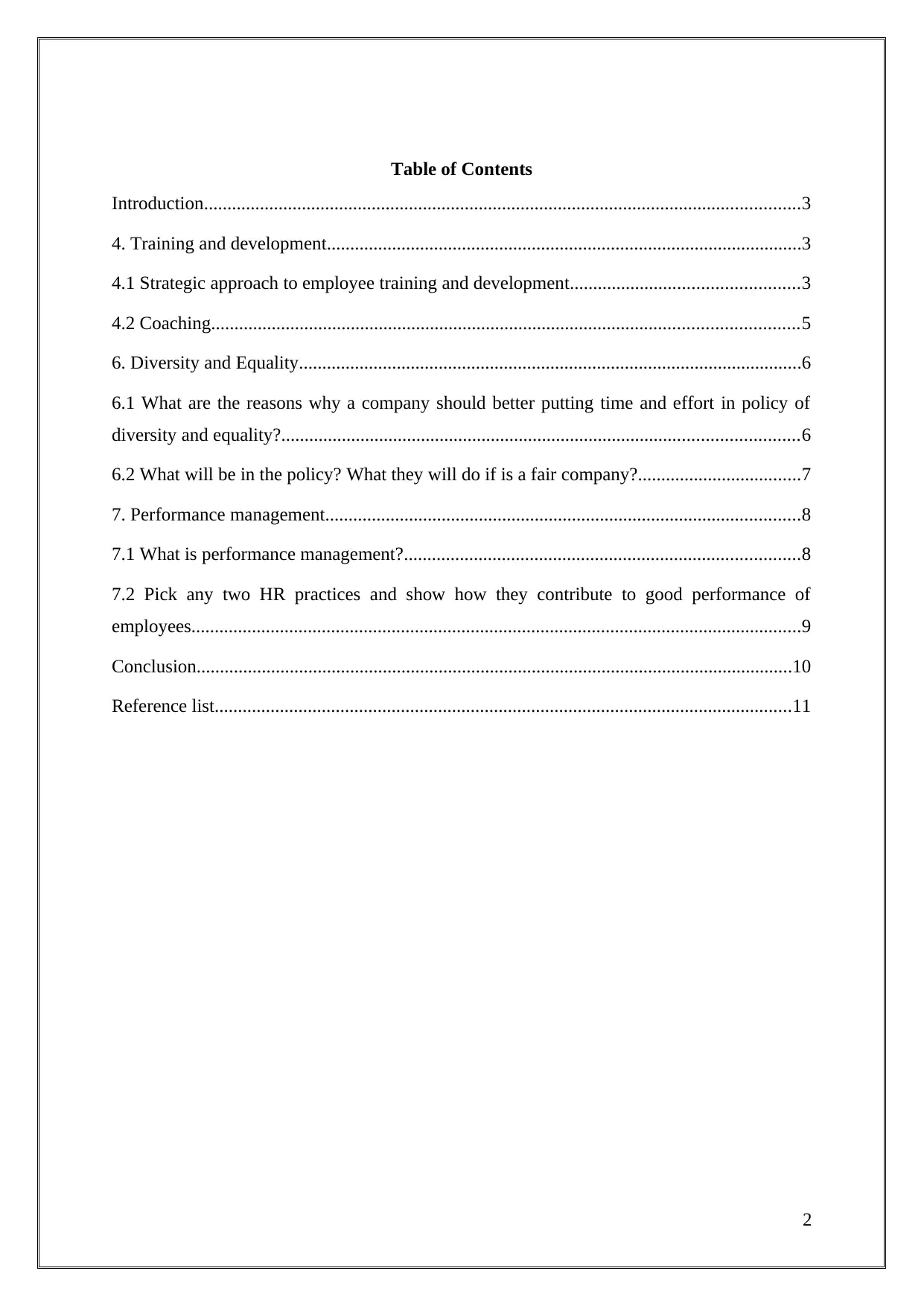
Table of Contents
Introduction................................................................................................................................3
4. Training and development......................................................................................................3
4.1 Strategic approach to employee training and development.................................................3
4.2 Coaching..............................................................................................................................5
6. Diversity and Equality............................................................................................................6
6.1 What are the reasons why a company should better putting time and effort in policy of
diversity and equality?...............................................................................................................6
6.2 What will be in the policy? What they will do if is a fair company?...................................7
7. Performance management......................................................................................................8
7.1 What is performance management?.....................................................................................8
7.2 Pick any two HR practices and show how they contribute to good performance of
employees...................................................................................................................................9
Conclusion................................................................................................................................10
Reference list............................................................................................................................11
2
Introduction................................................................................................................................3
4. Training and development......................................................................................................3
4.1 Strategic approach to employee training and development.................................................3
4.2 Coaching..............................................................................................................................5
6. Diversity and Equality............................................................................................................6
6.1 What are the reasons why a company should better putting time and effort in policy of
diversity and equality?...............................................................................................................6
6.2 What will be in the policy? What they will do if is a fair company?...................................7
7. Performance management......................................................................................................8
7.1 What is performance management?.....................................................................................8
7.2 Pick any two HR practices and show how they contribute to good performance of
employees...................................................................................................................................9
Conclusion................................................................................................................................10
Reference list............................................................................................................................11
2
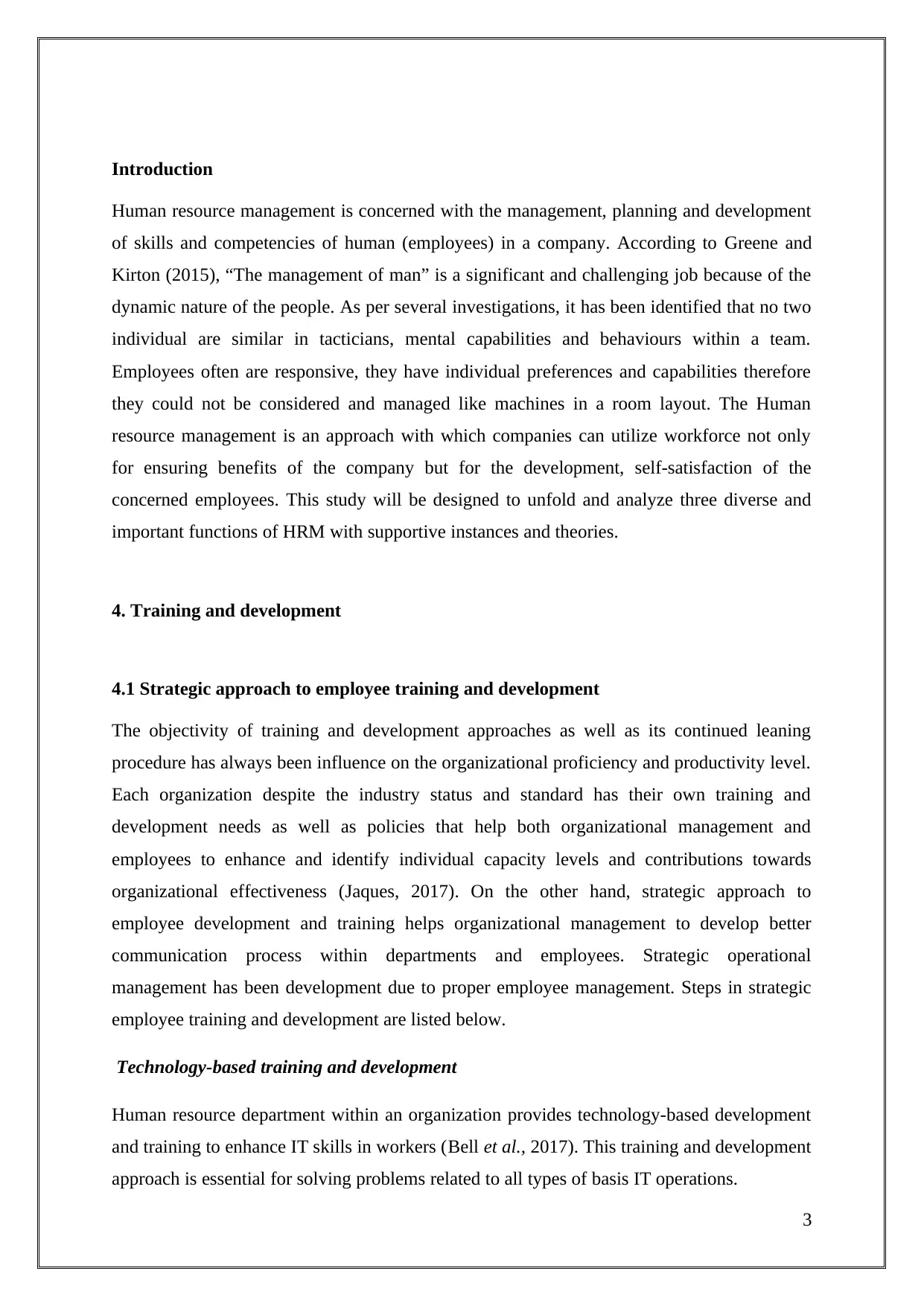
Introduction
Human resource management is concerned with the management, planning and development
of skills and competencies of human (employees) in a company. According to Greene and
Kirton (2015), “The management of man” is a significant and challenging job because of the
dynamic nature of the people. As per several investigations, it has been identified that no two
individual are similar in tacticians, mental capabilities and behaviours within a team.
Employees often are responsive, they have individual preferences and capabilities therefore
they could not be considered and managed like machines in a room layout. The Human
resource management is an approach with which companies can utilize workforce not only
for ensuring benefits of the company but for the development, self-satisfaction of the
concerned employees. This study will be designed to unfold and analyze three diverse and
important functions of HRM with supportive instances and theories.
4. Training and development
4.1 Strategic approach to employee training and development
The objectivity of training and development approaches as well as its continued leaning
procedure has always been influence on the organizational proficiency and productivity level.
Each organization despite the industry status and standard has their own training and
development needs as well as policies that help both organizational management and
employees to enhance and identify individual capacity levels and contributions towards
organizational effectiveness (Jaques, 2017). On the other hand, strategic approach to
employee development and training helps organizational management to develop better
communication process within departments and employees. Strategic operational
management has been development due to proper employee management. Steps in strategic
employee training and development are listed below.
Technology-based training and development
Human resource department within an organization provides technology-based development
and training to enhance IT skills in workers (Bell et al., 2017). This training and development
approach is essential for solving problems related to all types of basis IT operations.
3
Human resource management is concerned with the management, planning and development
of skills and competencies of human (employees) in a company. According to Greene and
Kirton (2015), “The management of man” is a significant and challenging job because of the
dynamic nature of the people. As per several investigations, it has been identified that no two
individual are similar in tacticians, mental capabilities and behaviours within a team.
Employees often are responsive, they have individual preferences and capabilities therefore
they could not be considered and managed like machines in a room layout. The Human
resource management is an approach with which companies can utilize workforce not only
for ensuring benefits of the company but for the development, self-satisfaction of the
concerned employees. This study will be designed to unfold and analyze three diverse and
important functions of HRM with supportive instances and theories.
4. Training and development
4.1 Strategic approach to employee training and development
The objectivity of training and development approaches as well as its continued leaning
procedure has always been influence on the organizational proficiency and productivity level.
Each organization despite the industry status and standard has their own training and
development needs as well as policies that help both organizational management and
employees to enhance and identify individual capacity levels and contributions towards
organizational effectiveness (Jaques, 2017). On the other hand, strategic approach to
employee development and training helps organizational management to develop better
communication process within departments and employees. Strategic operational
management has been development due to proper employee management. Steps in strategic
employee training and development are listed below.
Technology-based training and development
Human resource department within an organization provides technology-based development
and training to enhance IT skills in workers (Bell et al., 2017). This training and development
approach is essential for solving problems related to all types of basis IT operations.
3
⊘ This is a preview!⊘
Do you want full access?
Subscribe today to unlock all pages.

Trusted by 1+ million students worldwide
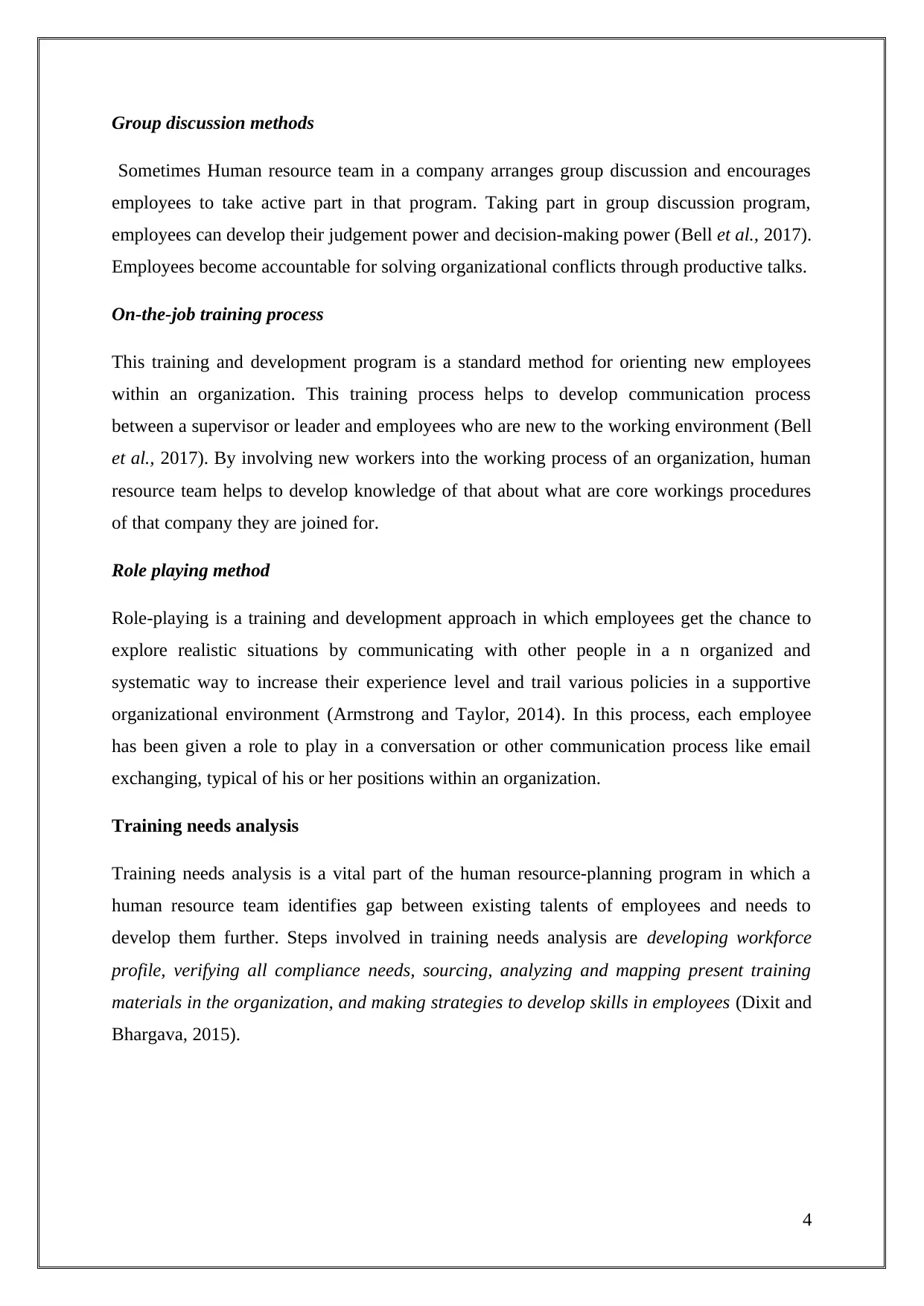
Group discussion methods
Sometimes Human resource team in a company arranges group discussion and encourages
employees to take active part in that program. Taking part in group discussion program,
employees can develop their judgement power and decision-making power (Bell et al., 2017).
Employees become accountable for solving organizational conflicts through productive talks.
On-the-job training process
This training and development program is a standard method for orienting new employees
within an organization. This training process helps to develop communication process
between a supervisor or leader and employees who are new to the working environment (Bell
et al., 2017). By involving new workers into the working process of an organization, human
resource team helps to develop knowledge of that about what are core workings procedures
of that company they are joined for.
Role playing method
Role-playing is a training and development approach in which employees get the chance to
explore realistic situations by communicating with other people in a n organized and
systematic way to increase their experience level and trail various policies in a supportive
organizational environment (Armstrong and Taylor, 2014). In this process, each employee
has been given a role to play in a conversation or other communication process like email
exchanging, typical of his or her positions within an organization.
Training needs analysis
Training needs analysis is a vital part of the human resource-planning program in which a
human resource team identifies gap between existing talents of employees and needs to
develop them further. Steps involved in training needs analysis are developing workforce
profile, verifying all compliance needs, sourcing, analyzing and mapping present training
materials in the organization, and making strategies to develop skills in employees (Dixit and
Bhargava, 2015).
4
Sometimes Human resource team in a company arranges group discussion and encourages
employees to take active part in that program. Taking part in group discussion program,
employees can develop their judgement power and decision-making power (Bell et al., 2017).
Employees become accountable for solving organizational conflicts through productive talks.
On-the-job training process
This training and development program is a standard method for orienting new employees
within an organization. This training process helps to develop communication process
between a supervisor or leader and employees who are new to the working environment (Bell
et al., 2017). By involving new workers into the working process of an organization, human
resource team helps to develop knowledge of that about what are core workings procedures
of that company they are joined for.
Role playing method
Role-playing is a training and development approach in which employees get the chance to
explore realistic situations by communicating with other people in a n organized and
systematic way to increase their experience level and trail various policies in a supportive
organizational environment (Armstrong and Taylor, 2014). In this process, each employee
has been given a role to play in a conversation or other communication process like email
exchanging, typical of his or her positions within an organization.
Training needs analysis
Training needs analysis is a vital part of the human resource-planning program in which a
human resource team identifies gap between existing talents of employees and needs to
develop them further. Steps involved in training needs analysis are developing workforce
profile, verifying all compliance needs, sourcing, analyzing and mapping present training
materials in the organization, and making strategies to develop skills in employees (Dixit and
Bhargava, 2015).
4
Paraphrase This Document
Need a fresh take? Get an instant paraphrase of this document with our AI Paraphraser
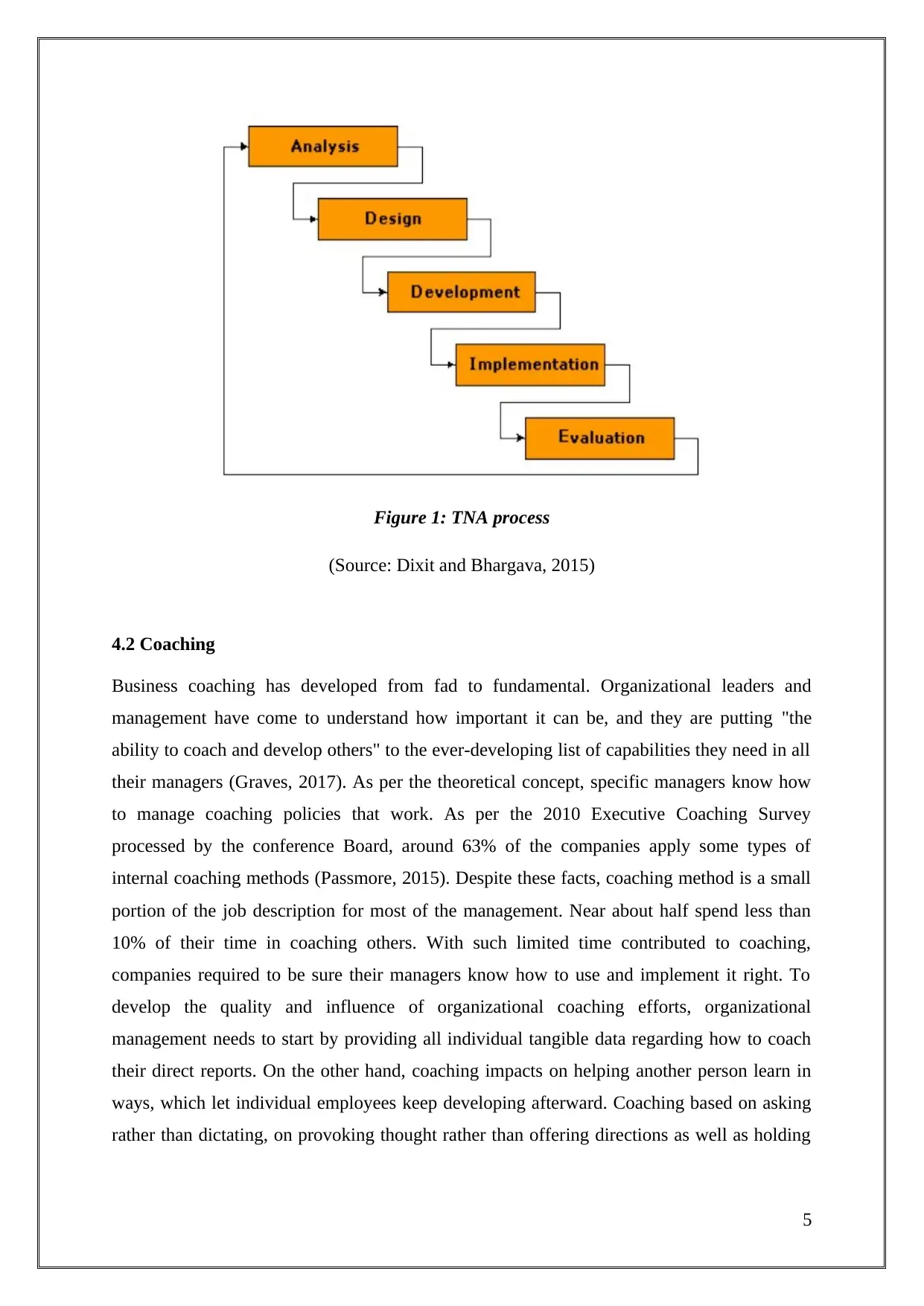
Figure 1: TNA process
(Source: Dixit and Bhargava, 2015)
4.2 Coaching
Business coaching has developed from fad to fundamental. Organizational leaders and
management have come to understand how important it can be, and they are putting "the
ability to coach and develop others" to the ever-developing list of capabilities they need in all
their managers (Graves, 2017). As per the theoretical concept, specific managers know how
to manage coaching policies that work. As per the 2010 Executive Coaching Survey
processed by the conference Board, around 63% of the companies apply some types of
internal coaching methods (Passmore, 2015). Despite these facts, coaching method is a small
portion of the job description for most of the management. Near about half spend less than
10% of their time in coaching others. With such limited time contributed to coaching,
companies required to be sure their managers know how to use and implement it right. To
develop the quality and influence of organizational coaching efforts, organizational
management needs to start by providing all individual tangible data regarding how to coach
their direct reports. On the other hand, coaching impacts on helping another person learn in
ways, which let individual employees keep developing afterward. Coaching based on asking
rather than dictating, on provoking thought rather than offering directions as well as holding
5
(Source: Dixit and Bhargava, 2015)
4.2 Coaching
Business coaching has developed from fad to fundamental. Organizational leaders and
management have come to understand how important it can be, and they are putting "the
ability to coach and develop others" to the ever-developing list of capabilities they need in all
their managers (Graves, 2017). As per the theoretical concept, specific managers know how
to manage coaching policies that work. As per the 2010 Executive Coaching Survey
processed by the conference Board, around 63% of the companies apply some types of
internal coaching methods (Passmore, 2015). Despite these facts, coaching method is a small
portion of the job description for most of the management. Near about half spend less than
10% of their time in coaching others. With such limited time contributed to coaching,
companies required to be sure their managers know how to use and implement it right. To
develop the quality and influence of organizational coaching efforts, organizational
management needs to start by providing all individual tangible data regarding how to coach
their direct reports. On the other hand, coaching impacts on helping another person learn in
ways, which let individual employees keep developing afterward. Coaching based on asking
rather than dictating, on provoking thought rather than offering directions as well as holding
5
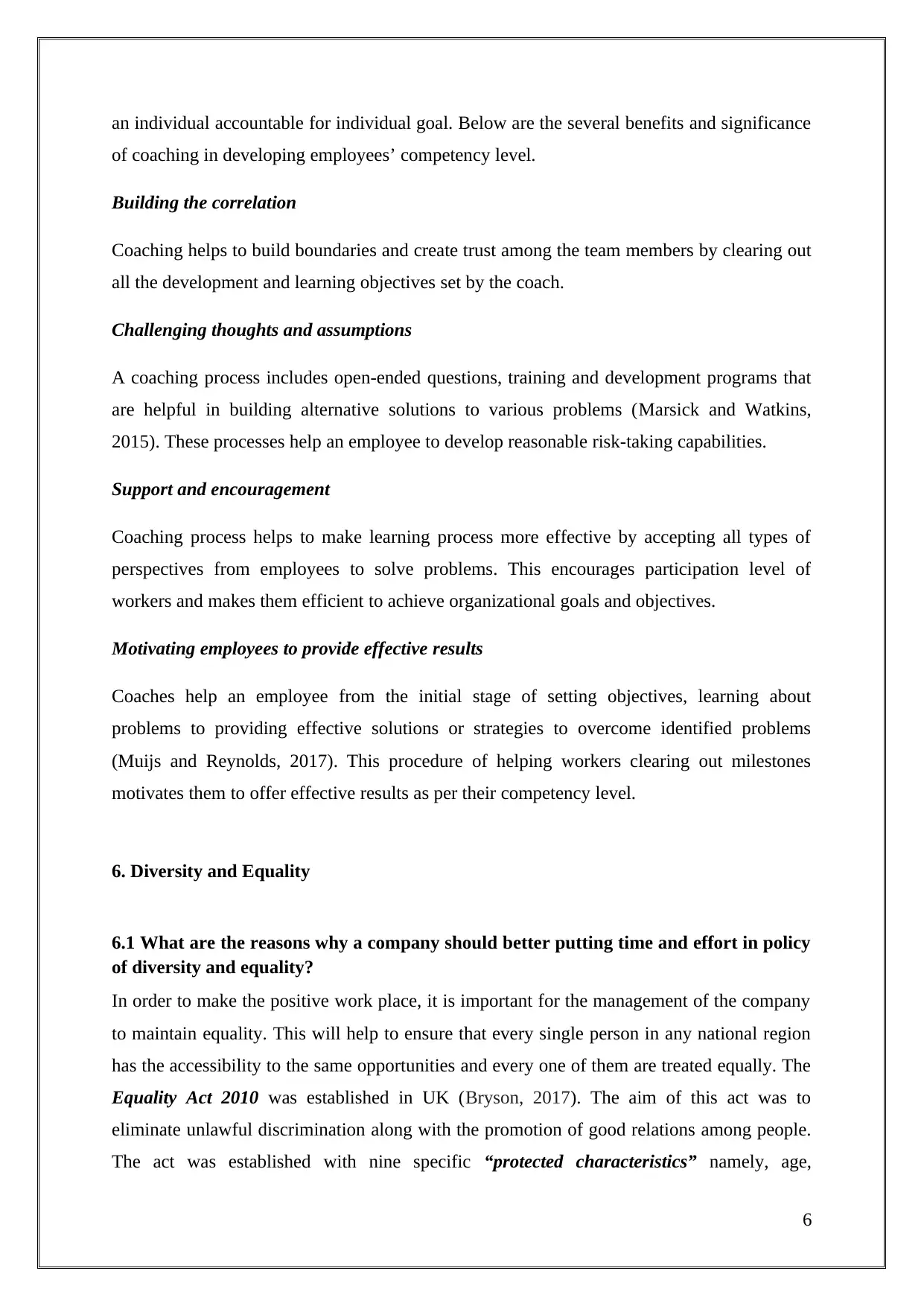
an individual accountable for individual goal. Below are the several benefits and significance
of coaching in developing employees’ competency level.
Building the correlation
Coaching helps to build boundaries and create trust among the team members by clearing out
all the development and learning objectives set by the coach.
Challenging thoughts and assumptions
A coaching process includes open-ended questions, training and development programs that
are helpful in building alternative solutions to various problems (Marsick and Watkins,
2015). These processes help an employee to develop reasonable risk-taking capabilities.
Support and encouragement
Coaching process helps to make learning process more effective by accepting all types of
perspectives from employees to solve problems. This encourages participation level of
workers and makes them efficient to achieve organizational goals and objectives.
Motivating employees to provide effective results
Coaches help an employee from the initial stage of setting objectives, learning about
problems to providing effective solutions or strategies to overcome identified problems
(Muijs and Reynolds, 2017). This procedure of helping workers clearing out milestones
motivates them to offer effective results as per their competency level.
6. Diversity and Equality
6.1 What are the reasons why a company should better putting time and effort in policy
of diversity and equality?
In order to make the positive work place, it is important for the management of the company
to maintain equality. This will help to ensure that every single person in any national region
has the accessibility to the same opportunities and every one of them are treated equally. The
Equality Act 2010 was established in UK (Bryson, 2017). The aim of this act was to
eliminate unlawful discrimination along with the promotion of good relations among people.
The act was established with nine specific “protected characteristics” namely, age,
6
of coaching in developing employees’ competency level.
Building the correlation
Coaching helps to build boundaries and create trust among the team members by clearing out
all the development and learning objectives set by the coach.
Challenging thoughts and assumptions
A coaching process includes open-ended questions, training and development programs that
are helpful in building alternative solutions to various problems (Marsick and Watkins,
2015). These processes help an employee to develop reasonable risk-taking capabilities.
Support and encouragement
Coaching process helps to make learning process more effective by accepting all types of
perspectives from employees to solve problems. This encourages participation level of
workers and makes them efficient to achieve organizational goals and objectives.
Motivating employees to provide effective results
Coaches help an employee from the initial stage of setting objectives, learning about
problems to providing effective solutions or strategies to overcome identified problems
(Muijs and Reynolds, 2017). This procedure of helping workers clearing out milestones
motivates them to offer effective results as per their competency level.
6. Diversity and Equality
6.1 What are the reasons why a company should better putting time and effort in policy
of diversity and equality?
In order to make the positive work place, it is important for the management of the company
to maintain equality. This will help to ensure that every single person in any national region
has the accessibility to the same opportunities and every one of them are treated equally. The
Equality Act 2010 was established in UK (Bryson, 2017). The aim of this act was to
eliminate unlawful discrimination along with the promotion of good relations among people.
The act was established with nine specific “protected characteristics” namely, age,
6
⊘ This is a preview!⊘
Do you want full access?
Subscribe today to unlock all pages.

Trusted by 1+ million students worldwide
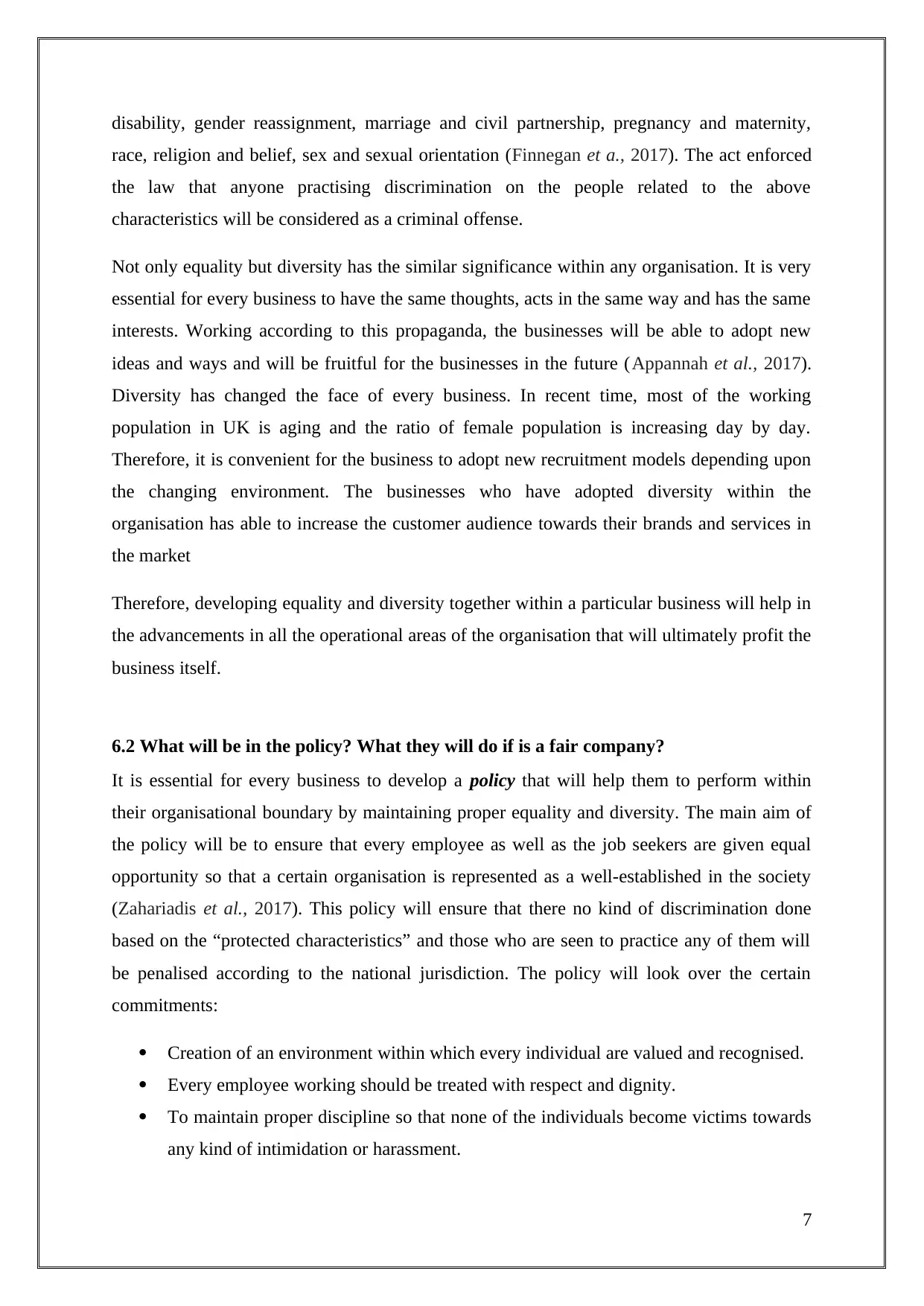
disability, gender reassignment, marriage and civil partnership, pregnancy and maternity,
race, religion and belief, sex and sexual orientation (Finnegan et a., 2017). The act enforced
the law that anyone practising discrimination on the people related to the above
characteristics will be considered as a criminal offense.
Not only equality but diversity has the similar significance within any organisation. It is very
essential for every business to have the same thoughts, acts in the same way and has the same
interests. Working according to this propaganda, the businesses will be able to adopt new
ideas and ways and will be fruitful for the businesses in the future (Appannah et al., 2017).
Diversity has changed the face of every business. In recent time, most of the working
population in UK is aging and the ratio of female population is increasing day by day.
Therefore, it is convenient for the business to adopt new recruitment models depending upon
the changing environment. The businesses who have adopted diversity within the
organisation has able to increase the customer audience towards their brands and services in
the market
Therefore, developing equality and diversity together within a particular business will help in
the advancements in all the operational areas of the organisation that will ultimately profit the
business itself.
6.2 What will be in the policy? What they will do if is a fair company?
It is essential for every business to develop a policy that will help them to perform within
their organisational boundary by maintaining proper equality and diversity. The main aim of
the policy will be to ensure that every employee as well as the job seekers are given equal
opportunity so that a certain organisation is represented as a well-established in the society
(Zahariadis et al., 2017). This policy will ensure that there no kind of discrimination done
based on the “protected characteristics” and those who are seen to practice any of them will
be penalised according to the national jurisdiction. The policy will look over the certain
commitments:
Creation of an environment within which every individual are valued and recognised.
Every employee working should be treated with respect and dignity.
To maintain proper discipline so that none of the individuals become victims towards
any kind of intimidation or harassment.
7
race, religion and belief, sex and sexual orientation (Finnegan et a., 2017). The act enforced
the law that anyone practising discrimination on the people related to the above
characteristics will be considered as a criminal offense.
Not only equality but diversity has the similar significance within any organisation. It is very
essential for every business to have the same thoughts, acts in the same way and has the same
interests. Working according to this propaganda, the businesses will be able to adopt new
ideas and ways and will be fruitful for the businesses in the future (Appannah et al., 2017).
Diversity has changed the face of every business. In recent time, most of the working
population in UK is aging and the ratio of female population is increasing day by day.
Therefore, it is convenient for the business to adopt new recruitment models depending upon
the changing environment. The businesses who have adopted diversity within the
organisation has able to increase the customer audience towards their brands and services in
the market
Therefore, developing equality and diversity together within a particular business will help in
the advancements in all the operational areas of the organisation that will ultimately profit the
business itself.
6.2 What will be in the policy? What they will do if is a fair company?
It is essential for every business to develop a policy that will help them to perform within
their organisational boundary by maintaining proper equality and diversity. The main aim of
the policy will be to ensure that every employee as well as the job seekers are given equal
opportunity so that a certain organisation is represented as a well-established in the society
(Zahariadis et al., 2017). This policy will ensure that there no kind of discrimination done
based on the “protected characteristics” and those who are seen to practice any of them will
be penalised according to the national jurisdiction. The policy will look over the certain
commitments:
Creation of an environment within which every individual are valued and recognised.
Every employee working should be treated with respect and dignity.
To maintain proper discipline so that none of the individuals become victims towards
any kind of intimidation or harassment.
7
Paraphrase This Document
Need a fresh take? Get an instant paraphrase of this document with our AI Paraphraser
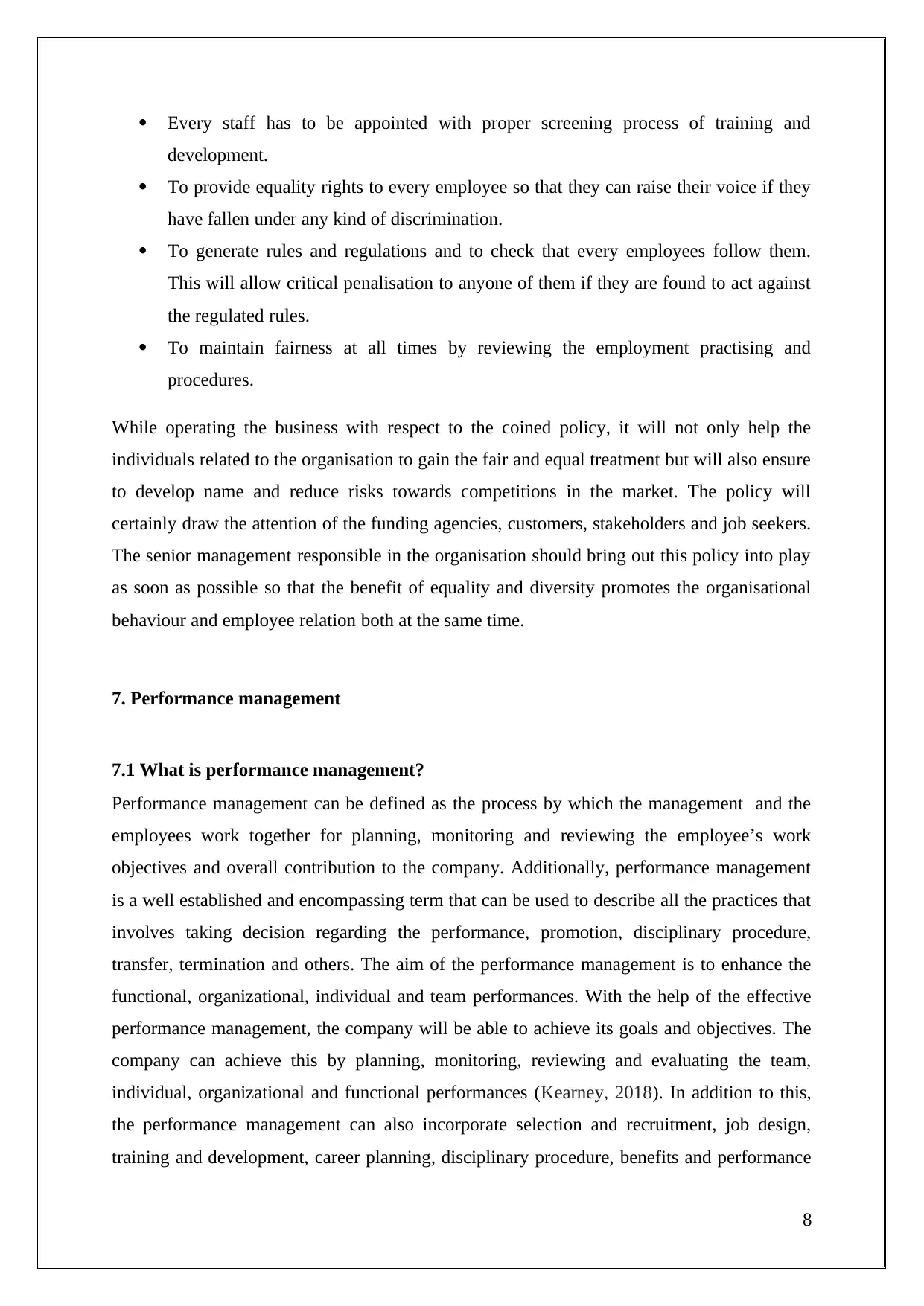
Every staff has to be appointed with proper screening process of training and
development.
To provide equality rights to every employee so that they can raise their voice if they
have fallen under any kind of discrimination.
To generate rules and regulations and to check that every employees follow them.
This will allow critical penalisation to anyone of them if they are found to act against
the regulated rules.
To maintain fairness at all times by reviewing the employment practising and
procedures.
While operating the business with respect to the coined policy, it will not only help the
individuals related to the organisation to gain the fair and equal treatment but will also ensure
to develop name and reduce risks towards competitions in the market. The policy will
certainly draw the attention of the funding agencies, customers, stakeholders and job seekers.
The senior management responsible in the organisation should bring out this policy into play
as soon as possible so that the benefit of equality and diversity promotes the organisational
behaviour and employee relation both at the same time.
7. Performance management
7.1 What is performance management?
Performance management can be defined as the process by which the management and the
employees work together for planning, monitoring and reviewing the employee’s work
objectives and overall contribution to the company. Additionally, performance management
is a well established and encompassing term that can be used to describe all the practices that
involves taking decision regarding the performance, promotion, disciplinary procedure,
transfer, termination and others. The aim of the performance management is to enhance the
functional, organizational, individual and team performances. With the help of the effective
performance management, the company will be able to achieve its goals and objectives. The
company can achieve this by planning, monitoring, reviewing and evaluating the team,
individual, organizational and functional performances (Kearney, 2018). In addition to this,
the performance management can also incorporate selection and recruitment, job design,
training and development, career planning, disciplinary procedure, benefits and performance
8
development.
To provide equality rights to every employee so that they can raise their voice if they
have fallen under any kind of discrimination.
To generate rules and regulations and to check that every employees follow them.
This will allow critical penalisation to anyone of them if they are found to act against
the regulated rules.
To maintain fairness at all times by reviewing the employment practising and
procedures.
While operating the business with respect to the coined policy, it will not only help the
individuals related to the organisation to gain the fair and equal treatment but will also ensure
to develop name and reduce risks towards competitions in the market. The policy will
certainly draw the attention of the funding agencies, customers, stakeholders and job seekers.
The senior management responsible in the organisation should bring out this policy into play
as soon as possible so that the benefit of equality and diversity promotes the organisational
behaviour and employee relation both at the same time.
7. Performance management
7.1 What is performance management?
Performance management can be defined as the process by which the management and the
employees work together for planning, monitoring and reviewing the employee’s work
objectives and overall contribution to the company. Additionally, performance management
is a well established and encompassing term that can be used to describe all the practices that
involves taking decision regarding the performance, promotion, disciplinary procedure,
transfer, termination and others. The aim of the performance management is to enhance the
functional, organizational, individual and team performances. With the help of the effective
performance management, the company will be able to achieve its goals and objectives. The
company can achieve this by planning, monitoring, reviewing and evaluating the team,
individual, organizational and functional performances (Kearney, 2018). In addition to this,
the performance management can also incorporate selection and recruitment, job design,
training and development, career planning, disciplinary procedure, benefits and performance
8
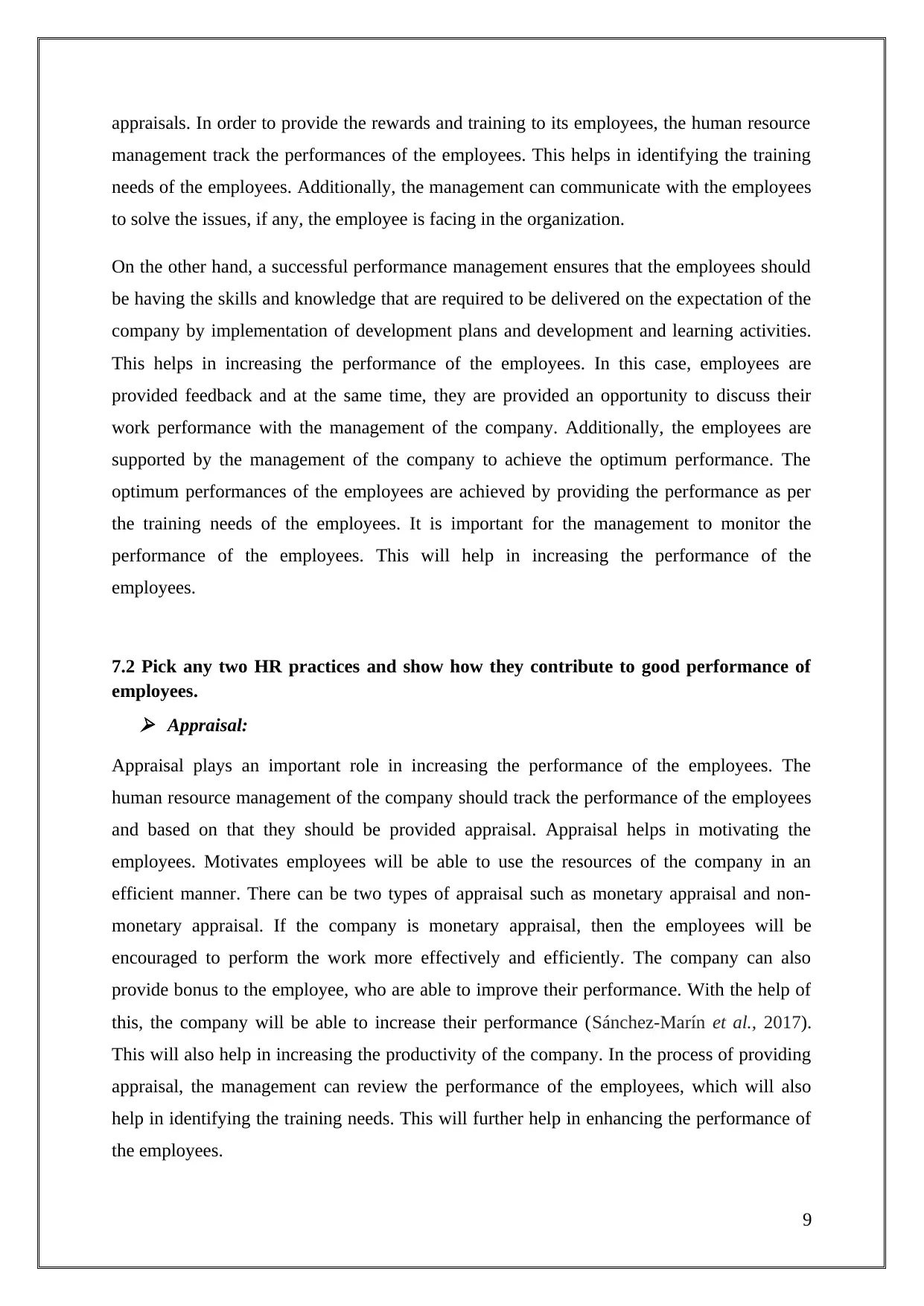
appraisals. In order to provide the rewards and training to its employees, the human resource
management track the performances of the employees. This helps in identifying the training
needs of the employees. Additionally, the management can communicate with the employees
to solve the issues, if any, the employee is facing in the organization.
On the other hand, a successful performance management ensures that the employees should
be having the skills and knowledge that are required to be delivered on the expectation of the
company by implementation of development plans and development and learning activities.
This helps in increasing the performance of the employees. In this case, employees are
provided feedback and at the same time, they are provided an opportunity to discuss their
work performance with the management of the company. Additionally, the employees are
supported by the management of the company to achieve the optimum performance. The
optimum performances of the employees are achieved by providing the performance as per
the training needs of the employees. It is important for the management to monitor the
performance of the employees. This will help in increasing the performance of the
employees.
7.2 Pick any two HR practices and show how they contribute to good performance of
employees. Appraisal:
Appraisal plays an important role in increasing the performance of the employees. The
human resource management of the company should track the performance of the employees
and based on that they should be provided appraisal. Appraisal helps in motivating the
employees. Motivates employees will be able to use the resources of the company in an
efficient manner. There can be two types of appraisal such as monetary appraisal and non-
monetary appraisal. If the company is monetary appraisal, then the employees will be
encouraged to perform the work more effectively and efficiently. The company can also
provide bonus to the employee, who are able to improve their performance. With the help of
this, the company will be able to increase their performance (Sánchez-Marín et al., 2017).
This will also help in increasing the productivity of the company. In the process of providing
appraisal, the management can review the performance of the employees, which will also
help in identifying the training needs. This will further help in enhancing the performance of
the employees.
9
management track the performances of the employees. This helps in identifying the training
needs of the employees. Additionally, the management can communicate with the employees
to solve the issues, if any, the employee is facing in the organization.
On the other hand, a successful performance management ensures that the employees should
be having the skills and knowledge that are required to be delivered on the expectation of the
company by implementation of development plans and development and learning activities.
This helps in increasing the performance of the employees. In this case, employees are
provided feedback and at the same time, they are provided an opportunity to discuss their
work performance with the management of the company. Additionally, the employees are
supported by the management of the company to achieve the optimum performance. The
optimum performances of the employees are achieved by providing the performance as per
the training needs of the employees. It is important for the management to monitor the
performance of the employees. This will help in increasing the performance of the
employees.
7.2 Pick any two HR practices and show how they contribute to good performance of
employees. Appraisal:
Appraisal plays an important role in increasing the performance of the employees. The
human resource management of the company should track the performance of the employees
and based on that they should be provided appraisal. Appraisal helps in motivating the
employees. Motivates employees will be able to use the resources of the company in an
efficient manner. There can be two types of appraisal such as monetary appraisal and non-
monetary appraisal. If the company is monetary appraisal, then the employees will be
encouraged to perform the work more effectively and efficiently. The company can also
provide bonus to the employee, who are able to improve their performance. With the help of
this, the company will be able to increase their performance (Sánchez-Marín et al., 2017).
This will also help in increasing the productivity of the company. In the process of providing
appraisal, the management can review the performance of the employees, which will also
help in identifying the training needs. This will further help in enhancing the performance of
the employees.
9
⊘ This is a preview!⊘
Do you want full access?
Subscribe today to unlock all pages.

Trusted by 1+ million students worldwide
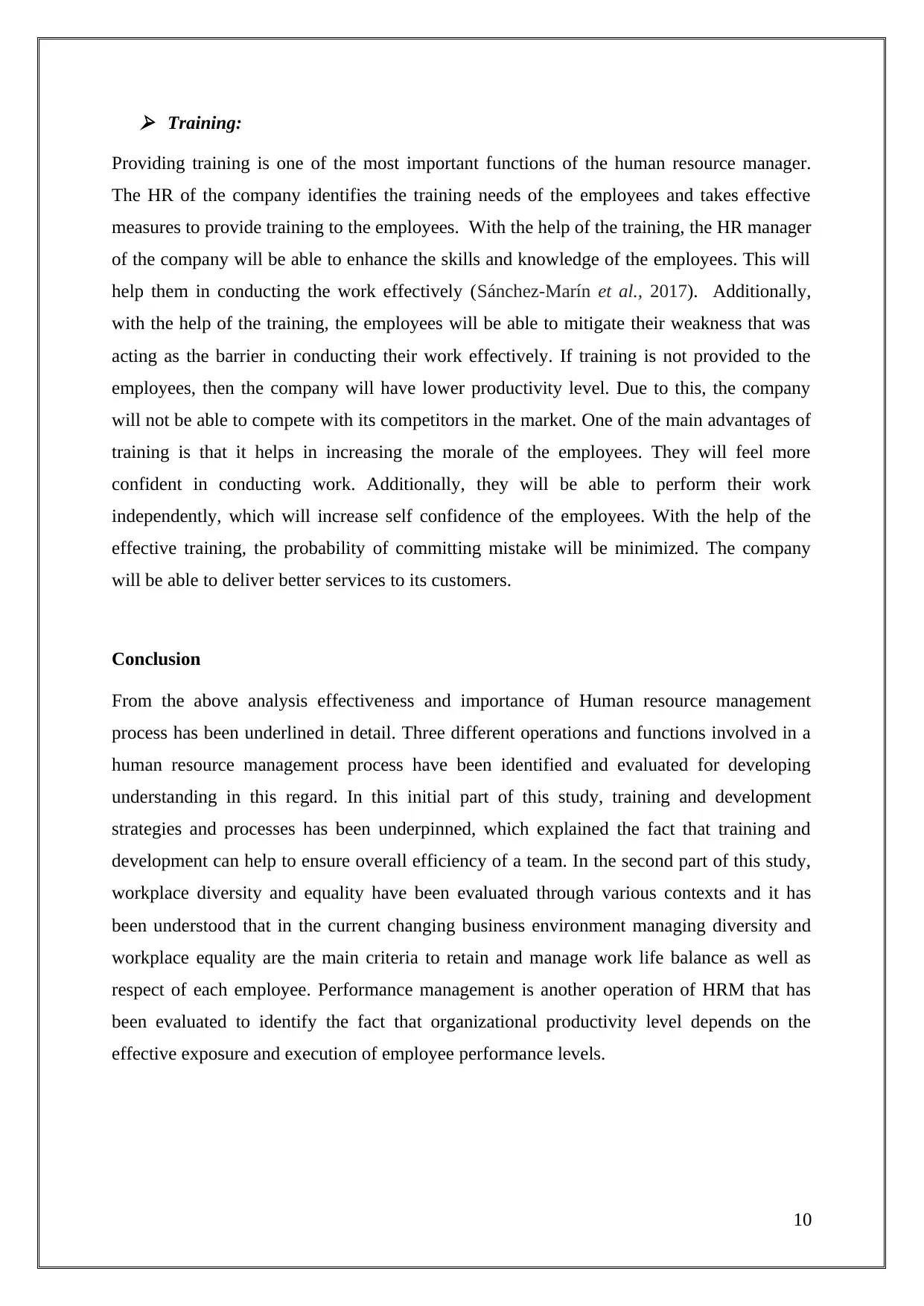
Training:
Providing training is one of the most important functions of the human resource manager.
The HR of the company identifies the training needs of the employees and takes effective
measures to provide training to the employees. With the help of the training, the HR manager
of the company will be able to enhance the skills and knowledge of the employees. This will
help them in conducting the work effectively (Sánchez-Marín et al., 2017). Additionally,
with the help of the training, the employees will be able to mitigate their weakness that was
acting as the barrier in conducting their work effectively. If training is not provided to the
employees, then the company will have lower productivity level. Due to this, the company
will not be able to compete with its competitors in the market. One of the main advantages of
training is that it helps in increasing the morale of the employees. They will feel more
confident in conducting work. Additionally, they will be able to perform their work
independently, which will increase self confidence of the employees. With the help of the
effective training, the probability of committing mistake will be minimized. The company
will be able to deliver better services to its customers.
Conclusion
From the above analysis effectiveness and importance of Human resource management
process has been underlined in detail. Three different operations and functions involved in a
human resource management process have been identified and evaluated for developing
understanding in this regard. In this initial part of this study, training and development
strategies and processes has been underpinned, which explained the fact that training and
development can help to ensure overall efficiency of a team. In the second part of this study,
workplace diversity and equality have been evaluated through various contexts and it has
been understood that in the current changing business environment managing diversity and
workplace equality are the main criteria to retain and manage work life balance as well as
respect of each employee. Performance management is another operation of HRM that has
been evaluated to identify the fact that organizational productivity level depends on the
effective exposure and execution of employee performance levels.
10
Providing training is one of the most important functions of the human resource manager.
The HR of the company identifies the training needs of the employees and takes effective
measures to provide training to the employees. With the help of the training, the HR manager
of the company will be able to enhance the skills and knowledge of the employees. This will
help them in conducting the work effectively (Sánchez-Marín et al., 2017). Additionally,
with the help of the training, the employees will be able to mitigate their weakness that was
acting as the barrier in conducting their work effectively. If training is not provided to the
employees, then the company will have lower productivity level. Due to this, the company
will not be able to compete with its competitors in the market. One of the main advantages of
training is that it helps in increasing the morale of the employees. They will feel more
confident in conducting work. Additionally, they will be able to perform their work
independently, which will increase self confidence of the employees. With the help of the
effective training, the probability of committing mistake will be minimized. The company
will be able to deliver better services to its customers.
Conclusion
From the above analysis effectiveness and importance of Human resource management
process has been underlined in detail. Three different operations and functions involved in a
human resource management process have been identified and evaluated for developing
understanding in this regard. In this initial part of this study, training and development
strategies and processes has been underpinned, which explained the fact that training and
development can help to ensure overall efficiency of a team. In the second part of this study,
workplace diversity and equality have been evaluated through various contexts and it has
been understood that in the current changing business environment managing diversity and
workplace equality are the main criteria to retain and manage work life balance as well as
respect of each employee. Performance management is another operation of HRM that has
been evaluated to identify the fact that organizational productivity level depends on the
effective exposure and execution of employee performance levels.
10
Paraphrase This Document
Need a fresh take? Get an instant paraphrase of this document with our AI Paraphraser
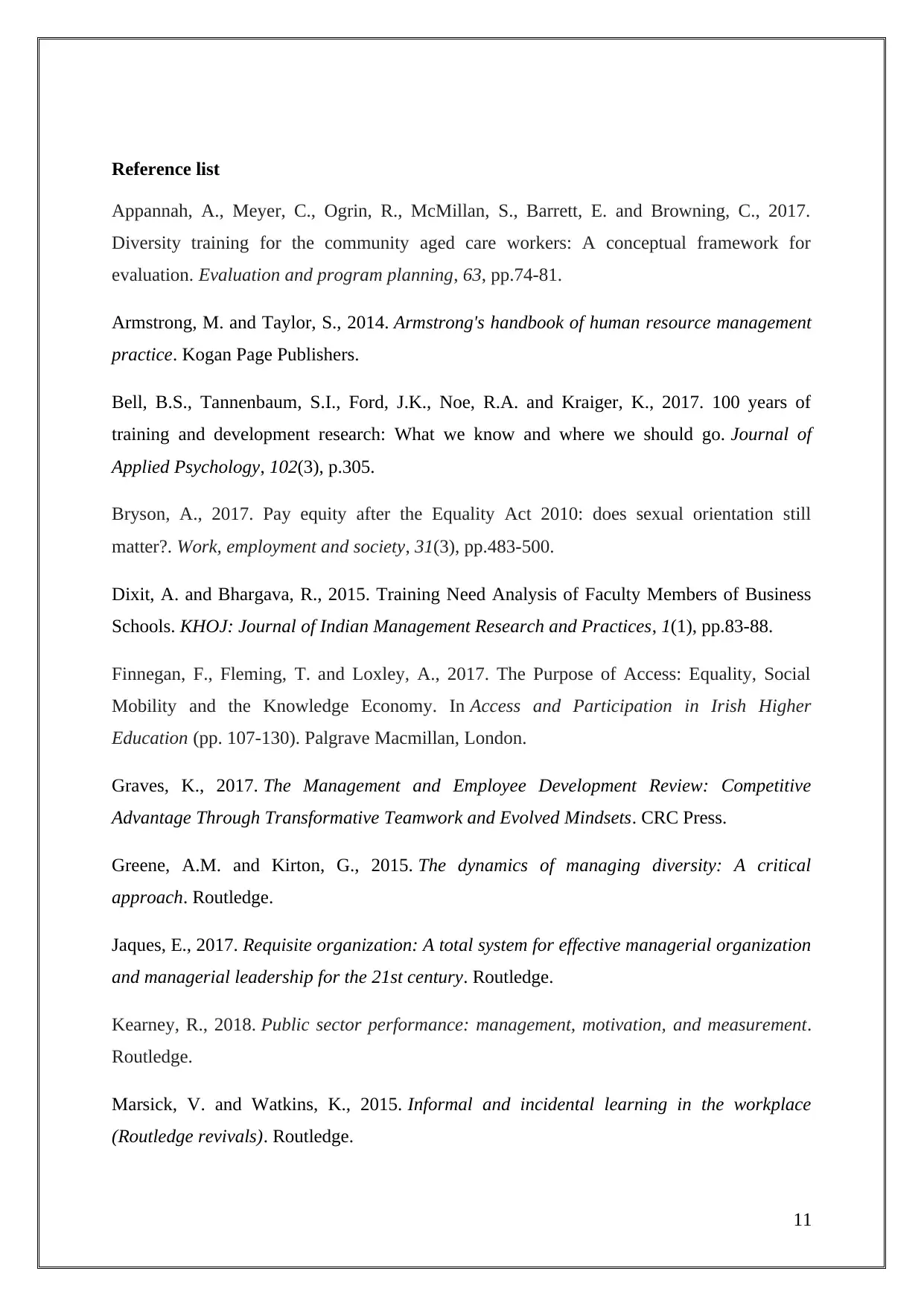
Reference list
Appannah, A., Meyer, C., Ogrin, R., McMillan, S., Barrett, E. and Browning, C., 2017.
Diversity training for the community aged care workers: A conceptual framework for
evaluation. Evaluation and program planning, 63, pp.74-81.
Armstrong, M. and Taylor, S., 2014. Armstrong's handbook of human resource management
practice. Kogan Page Publishers.
Bell, B.S., Tannenbaum, S.I., Ford, J.K., Noe, R.A. and Kraiger, K., 2017. 100 years of
training and development research: What we know and where we should go. Journal of
Applied Psychology, 102(3), p.305.
Bryson, A., 2017. Pay equity after the Equality Act 2010: does sexual orientation still
matter?. Work, employment and society, 31(3), pp.483-500.
Dixit, A. and Bhargava, R., 2015. Training Need Analysis of Faculty Members of Business
Schools. KHOJ: Journal of Indian Management Research and Practices, 1(1), pp.83-88.
Finnegan, F., Fleming, T. and Loxley, A., 2017. The Purpose of Access: Equality, Social
Mobility and the Knowledge Economy. In Access and Participation in Irish Higher
Education (pp. 107-130). Palgrave Macmillan, London.
Graves, K., 2017. The Management and Employee Development Review: Competitive
Advantage Through Transformative Teamwork and Evolved Mindsets. CRC Press.
Greene, A.M. and Kirton, G., 2015. The dynamics of managing diversity: A critical
approach. Routledge.
Jaques, E., 2017. Requisite organization: A total system for effective managerial organization
and managerial leadership for the 21st century. Routledge.
Kearney, R., 2018. Public sector performance: management, motivation, and measurement.
Routledge.
Marsick, V. and Watkins, K., 2015. Informal and incidental learning in the workplace
(Routledge revivals). Routledge.
11
Appannah, A., Meyer, C., Ogrin, R., McMillan, S., Barrett, E. and Browning, C., 2017.
Diversity training for the community aged care workers: A conceptual framework for
evaluation. Evaluation and program planning, 63, pp.74-81.
Armstrong, M. and Taylor, S., 2014. Armstrong's handbook of human resource management
practice. Kogan Page Publishers.
Bell, B.S., Tannenbaum, S.I., Ford, J.K., Noe, R.A. and Kraiger, K., 2017. 100 years of
training and development research: What we know and where we should go. Journal of
Applied Psychology, 102(3), p.305.
Bryson, A., 2017. Pay equity after the Equality Act 2010: does sexual orientation still
matter?. Work, employment and society, 31(3), pp.483-500.
Dixit, A. and Bhargava, R., 2015. Training Need Analysis of Faculty Members of Business
Schools. KHOJ: Journal of Indian Management Research and Practices, 1(1), pp.83-88.
Finnegan, F., Fleming, T. and Loxley, A., 2017. The Purpose of Access: Equality, Social
Mobility and the Knowledge Economy. In Access and Participation in Irish Higher
Education (pp. 107-130). Palgrave Macmillan, London.
Graves, K., 2017. The Management and Employee Development Review: Competitive
Advantage Through Transformative Teamwork and Evolved Mindsets. CRC Press.
Greene, A.M. and Kirton, G., 2015. The dynamics of managing diversity: A critical
approach. Routledge.
Jaques, E., 2017. Requisite organization: A total system for effective managerial organization
and managerial leadership for the 21st century. Routledge.
Kearney, R., 2018. Public sector performance: management, motivation, and measurement.
Routledge.
Marsick, V. and Watkins, K., 2015. Informal and incidental learning in the workplace
(Routledge revivals). Routledge.
11
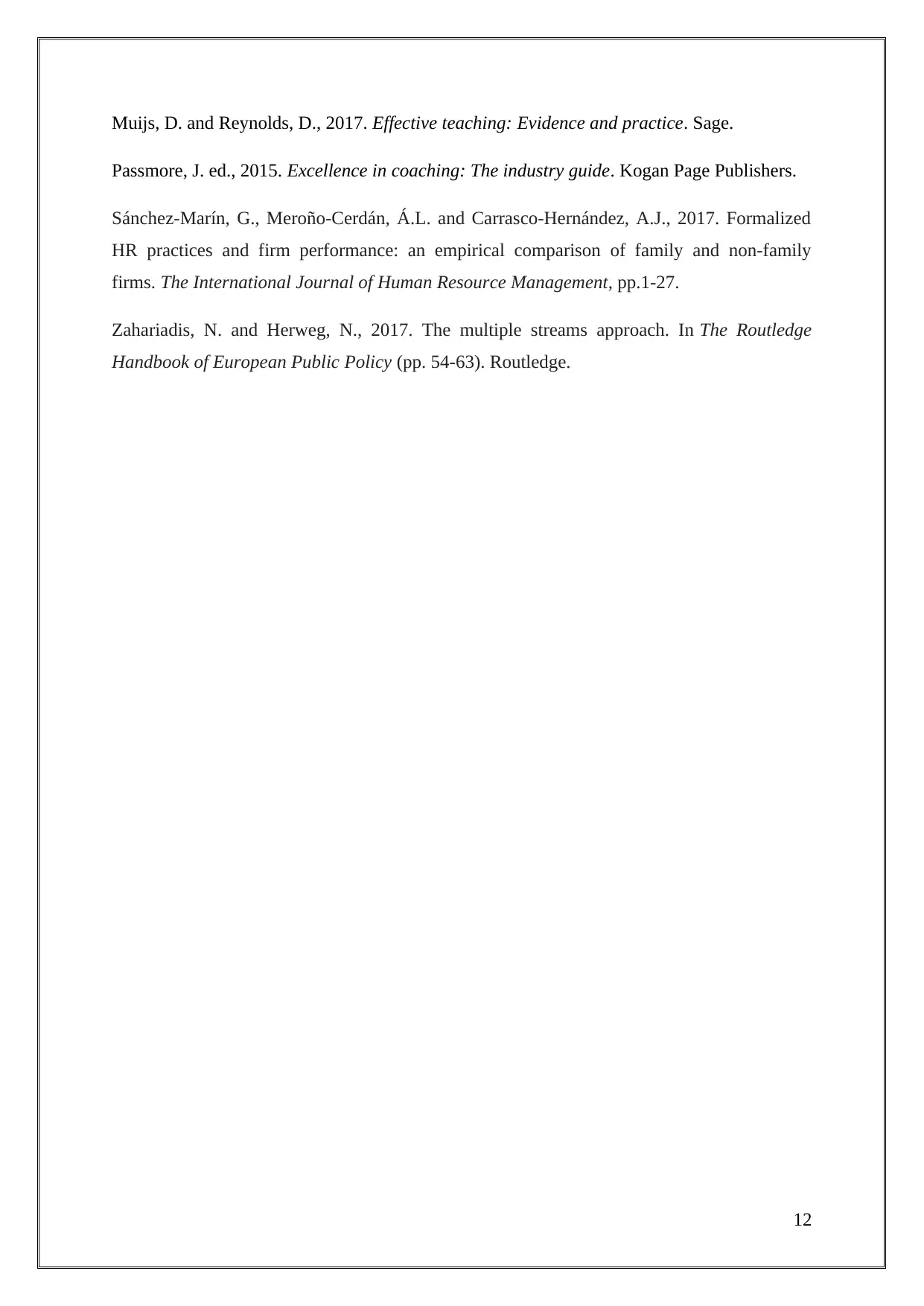
Muijs, D. and Reynolds, D., 2017. Effective teaching: Evidence and practice. Sage.
Passmore, J. ed., 2015. Excellence in coaching: The industry guide. Kogan Page Publishers.
Sánchez-Marín, G., Meroño-Cerdán, Á.L. and Carrasco-Hernández, A.J., 2017. Formalized
HR practices and firm performance: an empirical comparison of family and non-family
firms. The International Journal of Human Resource Management, pp.1-27.
Zahariadis, N. and Herweg, N., 2017. The multiple streams approach. In The Routledge
Handbook of European Public Policy (pp. 54-63). Routledge.
12
Passmore, J. ed., 2015. Excellence in coaching: The industry guide. Kogan Page Publishers.
Sánchez-Marín, G., Meroño-Cerdán, Á.L. and Carrasco-Hernández, A.J., 2017. Formalized
HR practices and firm performance: an empirical comparison of family and non-family
firms. The International Journal of Human Resource Management, pp.1-27.
Zahariadis, N. and Herweg, N., 2017. The multiple streams approach. In The Routledge
Handbook of European Public Policy (pp. 54-63). Routledge.
12
⊘ This is a preview!⊘
Do you want full access?
Subscribe today to unlock all pages.

Trusted by 1+ million students worldwide
1 out of 12
Related Documents
Your All-in-One AI-Powered Toolkit for Academic Success.
+13062052269
info@desklib.com
Available 24*7 on WhatsApp / Email
![[object Object]](/_next/static/media/star-bottom.7253800d.svg)
Unlock your academic potential
Copyright © 2020–2025 A2Z Services. All Rights Reserved. Developed and managed by ZUCOL.





